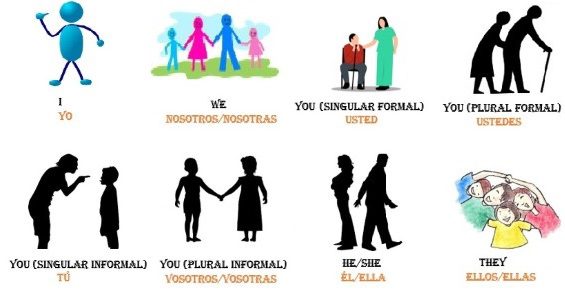Spanish subject pronouns are essential for the conjugation of verbs in Spanish. Pronouns like “yo“ (I) and “tú” (you) are used to determine how a verb should be conjugated. For example, if you wanted to say “I eat,“ then “yo” is how to say “I” in Spanish. So, you would use the subject pronoun “yo” and the conjugation of the Spanish verb “comer“ (to eat) in the first-person singular form, “como.” As you can see, Spanish subject pronouns are an integral part of understanding how to conjugate verbs in the language.
Subject personal pronouns in Spanish serve the same function as their English counterparts. They point out who carries out the action described by the verb.
| yo | I | 1st person singular |
| tú | you (informal) | 2nd person singular |
| usted | you (formal) | 2nd person singular |
| él/ella | he/she/it | 3rd person singular |
| nosotros/nosotras | we | 1st person plural |
| vosotros/vosotras | you (informal) | 2nd person plural |
| ustedes | you (formal) | 2nd person plural |
| ellos/ellas | they | 3rd person plural |
Dropping the Subject Pronoun in Spanish
More often than not, the subject personal pronoun is dropped because the verb endings can be sufficient to refer to the subject.
What is the importance of omitting the subject in a sentence?
Consider the example “Yo vivo en España” or “Vivo en España” (I live in Spain). Both are considered perfect speech and grammatically correct. It even sounds more native to drop the subject pronoun in informal speech. Opting to use the subject pronoun can sound less natural in some contexts, as it can indicate an emphasis on the subject rather than the verb.
What are the differences in subject pronouns in English and Spanish?
In English, verb conjugation in the present tense is quite simple. For example, the verb “to break” is conjugated as follows: I/you/we/they break, he/she/it breaks.
Thus, there are only two conjugation forms of the verb “to break” in the present tense, which are “break” and “breaks.” In Spanish, it is a little more complicated.
Regular Verb Conjugation in the Present Simple Tense
Let us examine the verb conjugations basics in the present simple tense in Spanish.
Regular verbs in the present simple tense follow the conjugation rules shown below, with an example from each verb group: –ar, –er, –ir.
Informal “Tú” vs. Formal “Usted”
There are two forms of singular “you” in Spanish. The first is the informal “tú” and is used with familiar people (e.g., child, relative, friend, peer, etc.). The second is the formal “usted” which is used with older people and with people we are not familiar with or to show respect.
In writing, you can abbreviate “usted” as “Ud.” and “ustedes” as “Uds.” where the abbreviation forms are always capitalized.
The accent on the “u” in “tú” is to distinguish it from the possessive pronoun “tu,” meaning “your,” and does not affect the pronunciation. Similarly, the accent is used to distinguish “él,” meaning “he” or “it,” from the definite article “el,” meaning “the.”
In some Spanish-speaking countries like Argentina, Uruguay, Paraguay, El Salvador, and Nicaragua, the informal “tú” is replaced with “vos” and has different verb conjugations.
“Nosotros” & “Vosotros”
The masculine pronouns “nosotros” and “vosotros” have the feminine forms “nosotras” and “vosotras,” respectively. The feminine forms are used for groups that consist exclusively of feminine-gender members.
Even if one masculine-gender member of that group exists, we must use “nosotros” and “vosotros.” The same gender rules apply to “ellos” and “ellas,” both meaning “they.”
In Latin America, “vosotros” is not used; instead, “ustedes” is used for both the formal and informal plural versions of “you.”
The Equivalent of the Subject Pronoun “it” in Spanish
There is no direct equivalent to the English subject pronoun “it.” Since all nouns in Spanish are either masculine or feminine, we use “él” or “ella” to refer to an object depending on whether it is masculine or feminine.
There is also the neuter personal pronoun “ello,” often translated as “it,” which refers to a statement or a situation. This is usually used in writing but seldom in spoken Spanish.
For example, “Ello no significa mucho” (It does not mean much). In spoken Spanish, you would use the masculine demonstrative pronoun “esto,” meaning “this,” e.g., “Esto no significa mucho.”
More details on demonstrative pronouns are discussed here.


